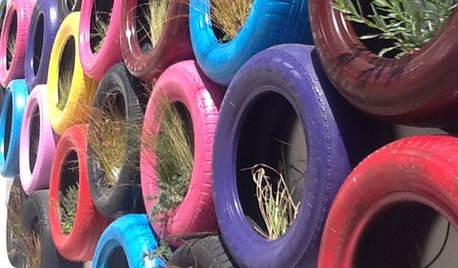Odor and off-gassing from new oak floors
Betsey Thompson
3 years ago
Related Stories

REMODELING GUIDESYour Floor: An Introduction to Solid-Plank Wood Floors
Get the Pros and Cons of Oak, Ash, Pine, Maple and Solid Bamboo
Full Story
TILETop Tile Trends From the Coverings 2013 Show — the Wood Look
Get the beauty of wood while waving off potential splinters, rotting and long searches, thanks to eye-fooling ceramic and porcelain tiles
Full Story
HOUZZ TOURSHouzz Tour: From Burned Down to Done Up in Las Vegas
A fire gutted this midcentury home — and laid the groundwork for a beautiful new floor plan
Full Story
SALVAGECan We Bounce Some Great Recycled-Rubber Ideas Off You?
No need to bemoan that spare tire. Old rubber is getting a guilt-free second life as flooring, pavers, sinks and even furniture
Full Story
LIFEHouse Rule: Off With Your Shoes
Do you prefer your guests to go shoeless in your house? Here are some ways to encourage stockinged feet
Full Story
FLOORS5 Benefits to Concrete Floors for Everyday Living
Get low-maintenance home flooring that creates high impact and works with home styles from traditional to modern
Full Story
LAUNDRY ROOMSTrending Now: Ideas From the Most Popular New Laundry Rooms
Mosaic tile floors, bold wallpaper and built-in benches are some of the features that can make your laundry room shine
Full Story
DECORATING GUIDESIsn’t It Good, Nordic Wood: The Appeal of Pale Floors
From silvery ash to honey blonde or chalk white, light-toned floors hold the key to the pared-back simplicity of Scandinavian style
Full Story
HOUZZ TOURSMy Houzz: Family Efforts Pay Off for a 1915 Home
Everyone from the kids to the grandparents helped renovate this Montreal house — and the results show how much they care
Full Story
GUESTHOUSESHouzz Tour: Oak and Natural Light Warm Up an English Cottage
A ground-level guesthouse with a curbless shower gives a grandmother a place to recover from surgery
Full StoryMore Discussions








SJ McCarthy
Betsey ThompsonOriginal Author
Related Professionals
Branford Flooring Contractors · Garfield Heights Flooring Contractors · New Orleans Flooring Contractors · Owatonna Flooring Contractors · Pearland Flooring Contractors · Seekonk Flooring Contractors · Woodbury Flooring Contractors · Ardmore Tile and Stone Contractors · Channahon Tile and Stone Contractors · Schofield Barracks Carpet Dealers · Alamo General Contractors · Auburn General Contractors · El Sobrante General Contractors · McPherson General Contractors · Rancho Santa Margarita General ContractorsTimothy Winzell
Betsey ThompsonOriginal Author